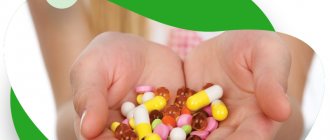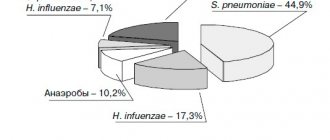An antibiotic (antibacterial drug, antimicrobial agent) is a drug that is effective in treating bacterial infections. Its effect is to directly affect the bacterium, it kills it. Its effect may also be to slow down the proliferation of bacteria, which allows the immune system to cope with it. The high prevalence of infections, a large selection of antibiotics for children, and the unjustified prescription of these drugs for diseases in children and adults have led to threatening consequences for human life—antibiotic resistance. According to the Eurasian recommendations, 25,000 deaths annually in the EU are associated with antibiotic resistance. At the moment, antimicrobial agents are an irreplaceable resource for humanity. Antibacterial resistance can be considered a threat to national security.
Before moving on to the choice of a children's antibiotic, consideration of dosage, duration of use, it is necessary to analyze and explain the main points in the formation of resistance to antibacterial agents. Only after this can one adequately judge the choice and approach to prescribing these medications.
Which brand of antibiotics is better to choose?
Often the same drug is produced by different pharmaceutical companies, so their composition and dosage may differ slightly. Doctors can advise the patient which manufacturer’s medication to buy so that the treatment is more effective. The best antibiotics are produced by the following companies:
- Astellas Pharma Europe is the Dutch representative office of a Japanese public company, which was founded through the merger of 2 pharmaceutical companies. In the 1970s they opened offices in Europe and the USA. In 2005, they merged and the headquarters were located in Tokyo. The company's mission is to improve people's health through the production of innovative and reliable medicines.
- KRKA is an international pharmaceutical company headquartered in Slovenia. Founded in 1954 as a small laboratory. Produces generic drugs. Their active ingredient is the same as the original, but the composition contains other auxiliary components. The company's factories are located in Germany, Poland, Russia, Croatia, and Slovenia.
- Dalkhimpharm is the legal successor of the Khabarovsk Chemical Plant, which was founded in 1939. It is considered one of the oldest drug production enterprises in Russia and is one of the country's top ten pharmaceutical manufacturers. The main principle of work is to provide clients with effective, high-quality and safe drugs. All products are tested by the Moscow quality control center.
- Sandoz is a pharmaceutical company founded in Germany by Eduard Sandoz and Alfred Kern in 1886. It produces generics that are used in the treatment of various diseases. Products are represented in the markets of more than 140 countries. Now it is one of the top three producers of amoxicillin.
- Laboratoires Bouchara -Recordati – founded in Italy in 1926. In 1999 and 2000, he acquired pharmaceutical companies in France, at whose factories he began production of the antibiotic framycetin under the trade name Isofra. The company's products are represented in the markets of Europe, the USA, Canada, South America, and North Africa. The company's goal is to improve the quality of life of people.
- JSC FP "Obolenskoe" is a Russian company, created on the basis of the State Scientific Center for Applied Microbiology in 1994. Since 2013, it has been part of the Alvansa group of companies. The quality of products, according to the results of external audits, meets international standards. The company produces more than 150 drugs of various pharmacotherapeutic groups. Among them there are generics and innovative developments.
- Pliva is the largest pharmaceutical company in Southern Europe with its head office in Zagreb, Croatia. Founded in 1921, since 2008 acquired by TEVA and operates as its department. The main activity is aimed at the development and production of generics. The most popular antibiotic of this company is Sumamed.
- GlaxoSmithKline is a British pharmaceutical company founded in 2000 through the merger of two companies. Representative offices are opened in Germany, Italy, Australia, Canada, Poland and other countries. The main factories are located in Singapore, USA, UK, Spain. Products are represented on the markets of 160 countries. A popular drug from this company is considered a strong broad-spectrum antibiotic Augmentin.
- PJSC Biosintez is a group of companies that includes the largest Russian pharmaceutical enterprises. Founded in Penza in 1955. The first antibiotic was released in 1959. It ranks 5th in the world in the production of generic drugs. The quality of medicines is recognized in 150 countries.
- Olain Farm is the largest pharmaceutical company in the Baltic countries, founded in 1972. The headquarters is located in Latvia. The quality of the products is confirmed by audits of well-known companies in Switzerland, the USA, and France. In the territory of the former USSR, the company became the first whose drug was included in the WHO list.
- Synthesis is a Russian plant, created on the basis of the Kurgan Medicinal Products Plant for the production of antibiotics. Also produces vitamin B12 and endocrine drugs. Since 1987, engineers have introduced new technology for producing ampicillin trihydrate.
Antibiotic rating
Based on the principle of action, drugs are divided into 2 types: bactericidal and bacteriostatic. The former contribute to the death of bacteria by destroying their cell membrane, the latter slow down the reproduction and growth of pathogenic microorganisms, which allows the human immune system to overcome the infection. Your doctor should determine which antibiotics are best to take. It takes into account the patient’s age, type of disease, and the presence of concomitant pathologies. When choosing nominees for the top, an analysis of the results of comparative tests of the following characteristics of medicines was carried out:
- Release form;
- Presence and number of contraindications;
- Origin and type of antibiotic;
- Possibility of negative effect on body systems;
- Indications for use;
- Minimum age of use;
- Storage conditions;
- Features of interaction with other drugs;
- Influence on human psychomotor reactions.
Patient reviews of drug treatment, availability in pharmacies, and price were also taken into account. In the review, the nominees are divided into 5 categories based on the principle of nomination. Each contains a description of a specific antibiotic, its advantages and disadvantages.
The best antipyretics
Myth. Modern antibiotics are so “strong” that not a single bacteria can resist them.
Is it true.
In fact, one of the most pressing problems of modern pharmacology and healthcare in general is the rapid development of resistant strains of bacteria, which are also resistant to modern antibiotics of the latest generations. The emergence of resistance has been registered for each class of antimicrobial drugs without exception. It can develop at any stage of achieving a therapeutic effect (and even several at once). The main mechanisms for the development of resistance [1, 2]:
- Initially resistant strains. For example, some gram-negative bacteria have outer cell membranes that protect their cells from the action of a number of penicillins and cephalosporins.
- Spontaneous mutations leading to the emergence of organisms resistant to antibiotics.
- The transmission of antimicrobial resistance genes is the most common and important mechanism for the development of antibiotic resistance.
Antibiotic resistance is a global problem that can have unpredictable consequences for each of us. Alas, consumers themselves make a huge contribution to its existence. It is appropriate to remind customers of this with prescriptions for antibiotics, emphasizing that the risk of developing resistant strains can be significantly reduced by taking antimicrobial drugs only as prescribed by a doctor and strictly observing the dose and regimen of antibiotic therapy.
The best antibiotics for sinusitis
If, during inflammation of the paranasal sinuses, a patient experiences a high temperature and purulent nasal discharge, then a bacterial infection is likely to develop. After examination, doctors prescribe a course of antibiotics in the form of tablets, injections or nasal spray. The need for its use is due to the high risk of infection spreading to the brain. Analysis of test data and user opinions made it possible to identify the 2 best drugs from the 5 nominees.
Flemoklav solutab
The medicine is produced only in the form of tablets that dissolve in the mouth. In terms of the type of active components, the drug is identical to Amoxiclav; it has a bactericidal effect on a wide range of pathogenic microorganisms. The mechanism of their action, scope of application, contraindications, and the degree of development of side effects are the same.
Advantages
- Quick effect of treatment;
- Used for infections caused by different types of bacteria;
- Large list of indications for use;
- Few side effects;
- Minimal risk of developing dysbacteriosis.
Flaws
- High price;
- Prescribed only from 12 years of age.
Patients with sinusitis note a quick solution to the problem of severe inflammation. The number of tablets in a package is usually enough for a course of treatment, which rarely exceeds 7 days. Patients consider the price level to be high compared to other analogues.
Isofra
Inexpensive local antibiotic made in France. The active substance framycetin has bactericidal properties. Affects microorganisms that are resistant to penicillins. The high safety of the antibiotic is due to a small list of contraindications and the development of side effects only when used for more than 10 days. It is produced in the form of a 15 ml nasal spray. Used when there is no damage to the partitions.
Advantages
- Shelf life – 36 months;
- No significant interactions of the drug with other drugs have been identified;
- Overdose is unlikely;
- Average price;
- Allowed for the treatment of children;
- Does not affect the functioning of internal organs.
Flaws
- Need to use at least 4-6 times a day;
- Pneumococci and streptococci are resistant to the drug.
Most patients leave positive reviews about the medication. Its effectiveness allows you to quickly cure sinusitis in the acute phase and reduce the relapse of the chronic stage. However, it does not help everyone, so if there is no result after 7 days of use, the doctor selects an antibiotic from a different group.
The best remedies for sore throat
Myth. Tetracyclines are traditionally “weak” antibiotics, much less powerful than penicillins
Is it true.
In fact, tetracyclines have a wide range of antibacterial activity, and their modern representatives act against an even larger number of bacteria than their predecessors, including a number of pathogens that are resistant to other classes of antibiotics. Thus, tigecycline, which appeared on the market only in the mid-2000s, was developed as part of a program to combat the growing antibiotic resistance of such “complex” pathogens as Staphylococcus aureus and Escherichia coli [6].
Tetracyclines, including tetracycline and doxycycline, which have been used for decades, are able to penetrate into cells, which is why they are still widely used today to treat intracellular sexually transmitted infections (chlamydia, ureaplasmosis, mycoplasmosis). Indications for their use also include Helicobacter pylori infection - as part of eradication therapy. Due to its effectiveness against Propionibacterium acne
tetracyclines, along with macrolides, are used to treat acne.
Minocycline, whose spectrum includes Neisseria meningitidis
, is used to prevent meningococcal infection [2].
As a fly in the ointment, it should be mentioned that most tetracyclines (with the exception of modern representatives) are characterized by a high level of secondary resistance of many bacteria and, in addition, cross-resistance of microorganisms [3]. And this, undoubtedly, in many cases reduces their relevance.
The best antibiotics for colds
The disease is usually viral in nature. Antibacterial therapy is carried out only if there is no effect on the drugs and the development of symptoms such as yellow or green nasal discharge, deep cough with copious sputum, and temperature above 38 degrees. The prescription of the drugs is due to the high risk of complications such as otitis media, bronchitis, and tonsillitis. According to patient reviews, 2 nominees were selected from 10 drugs for the list of the best antibiotics for colds.
Azithromycin
A semisynthetic antibiotic obtained by modifying classical macrolides. It inhibits bacterial cell protein synthesis. In small doses it has a bacteriostatic effect, and in high concentrations it has a bactericidal effect. It is effective against influenza, which is accompanied by otitis media, bronchitis, and tonsillitis. Available in the form of tablets, capsules, and powder for preparing a suspension.
Advantages
- Quick effect, the course of treatment lasts 2-5 days;
- Low price;
- The suspension is allowed from 6 months;
- Wide spectrum of action;
- The therapeutic effect lasts up to 7 days.
Flaws
- A large list of contraindications and side effects;
- Affects the psychomotor reactions of the body;
- It is not recommended to take it together with a number of drugs.
Pediatricians confirm the high effectiveness of the antibiotic for children with coughs, if the cold turns into bronchitis, tracheitis. At the same time, there is a high risk of developing side effects, so it must be taken strictly in the indicated dosage. The advantages include low price, elimination of symptoms in a short time.
Sumamed
In terms of active substance and release form, the drug is similar to Azithromycin. An identical mechanism of action allows you to eliminate cold symptoms in 2-3 days. It is recommended for patients with allergies to penicillins. The minimum age for taking the suspension is 3 years, tablets – 18 years. The bitter taste of the drug causes discomfort when treating children.
Advantages
- Long half-life;
- Ease of reception;
- Rare development of hypersensitivity reaction;
- Wide spectrum of action;
- No significant effect on other drugs has been established.
Flaws
- High price;
- During treatment, diarrhea, vomiting, headache, and candidiasis often occur.
According to patients, Sumamed is a good antibiotic for colds in adults. Take it once a day, cold symptoms and complications disappear after a minimum period of time. The main disadvantages of the drug are the high price and the likelihood of lack of effect.
Principles of treatment
A person becomes infected with a viral infection through the mucous membranes of the eyes and nasopharynx. The incubation period lasts about a week. At this time, symptoms may occur in the form of aches and malaise. During the acute phase, the temperature rises, headaches, cough, runny nose, chills, and nausea appear. The severe phase of the disease causes severe shortness of breath, pain in the abdomen and chest. To prevent serious complications, it is important to quickly and correctly select treatment.
There is currently no vaccine for coronavirus. The course of treatment is based on the use of antiviral medications and antibiotics. The patient is prescribed a potent drug. An antiviral substance will not be able to cope with the virus on its own, so additional painkillers, antipyretics and sorbent medications are taken.
Antibiotics are prescribed for a complicated form of the disease, when opportunistic microflora multiply.
The best broad-spectrum antibiotics
Narrowly targeted drugs are often chosen because they have a lower risk of side effects. At the same time, they affect only a certain strain of bacteria, and the causative agents of infection are often various types of pathogenic microorganisms. Treatment with a broad-spectrum antibiotic will speed up recovery. Another advantage of their use is that there is no need to take a culture to determine the sensitivity of bacteria to the antibiotic, the results of which can take 7-10 days. The best antibiotics of this type were selected from 15 nominees. The leading positions in comparative tests were occupied by 2 medications.
Augmentin
The medicine is an analogue of Amoxiclav, since their active components are identical. Both drugs are classified as broad-spectrum antibiotics and have a bactericidal effect. In this case, the effect of intravenous administration of Amoxiclav occurs within 5-10 minutes. Augmentin release forms do not have such a speed. A small list of excipients reduces the risk of developing intolerance to the drug.
Advantages
- Prescribed if there are contraindications to taking Amoxiclav;
- Average price;
- Wide spectrum of action;
- Soft action;
- Less harm to the child's body.
Flaws
- Possible negative impact on the functioning of the kidneys and intestines;
- After taking it, it is not recommended to drive;
- Incompatibility with a number of medications.
ENT doctors recommend Augmentin for purulent tonsillitis, and pediatricians note its high effectiveness for pneumonia in children. Patients with sinusitis claim that they forget about the disease after 2 weeks of taking an antibiotic.
With cystitis, unpleasant symptoms disappear after 7 days of treatment. Respondents rate the safety of the medicine as 4.
Tetracycline
The cheapest drug in the rating with the active substance of the same name, which has bacteriostatic properties. For treatment, tablets, external or eye ointment have been used by every adult at least once in their life. Children are allowed to take the medicine from 8 years of age. Tetracycline is contraindicated in case of renal failure, hypersensitivity to the components of the composition, leukopenia, during pregnancy and lactation. It does not affect the speed of psychomotor reactions.
Advantages
- Wide spectrum of action;
- Quickly eliminates cough, reduces temperature;
- Effective for a large list of pathologies;
- Accessible.
Flaws
- Large list of adverse reactions;
- Cannot be combined with cephalosporins and penicillins.
The quality and safety of the drug are highly rated; 98% of patients recommend it for the treatment of diseases of an infectious and inflammatory nature. Many people use it for conjunctivitis, purulent wounds, throat diseases and cystitis. The disadvantages include the body's standard reaction to taking an antibiotic.
The best antibiotics for children
A child’s immunity is formed before the age of 13-16, so his body is more susceptible to pathogenic organisms. It is easier to choose a good antibiotic for an adult, because the doctor usually does not need to take into account the patient’s age. When treating children, this characteristic is important. The dosage of the drug depends on it. It is difficult to predict the effect of a medicine on a child’s body, so pediatricians choose a medicine with a minimum number of side effects. Analysis of reviews from doctors and parents made it possible to select 2 safe children's antibiotics from 5 nominees.
Furadonin
The active component of the antimicrobial agent nitrofuran has bacteriostatic and bactericidal properties. The drug is prescribed to children over 1 month of age. The daily dose is divided into 4 doses. The course of treatment lasts 7 days, but if necessary, the doctor can increase it to 10 days. Contraindications include pregnancy, severe kidney and heart diseases.
Advantages
- Low price;
- The development of resistance in bacteria to the drug has not been recorded;
- Does not affect psychomotor reactions;
- The maximum effect occurs after 30-40 minutes;
- Shelf life – 48 months.
Flaws
- Available only in tablet form;
- Prescribed mainly for urinary tract infections;
- Incompatible with fluoroquinolones.
Parents confirm the effectiveness of treatment of cystitis with Furadonin in children. Side effects are rare, pain when urinating goes away within a day. After taking a urine test again 4 days later, all parameters were normal. The medicine can be mixed with fruit drink or tea so that the child does not feel an unpleasant taste.
Cephalexin
Antibiotic of the cephalosporin group with bactericidal properties. In the form of a suspension, it is allowed for children from 6 months, and tablets are prescribed only from 3 years. It is considered the best antibiotic for otitis media, pathologies of the respiratory and urinary systems in children. The dosage depends on age, weight and type of disease.
Advantages
- Ease of reception;
- Low price;
- One of the few cephalosporins that are available in oral form;
- Shelf life – 36 months;
- Small list of contraindications;
- Enhances the effect of a number of medications.
Flaws
- Affects psychomotor reactions;
- Possible development of adverse reactions;
- Not active against anaerobic microorganisms.
Reviews about the antibiotic for children are mostly positive. Parents confirm its high effectiveness and safety. The disadvantages include difficulties in calculating the dosage. The pleasant taste eliminates the main problem of the child taking the medicine.
Which antibiotic is better to buy?
Doctors do not advise doctors to choose a medication on their own, especially when treating children. The wrong medicine can only worsen the patient's condition. The main criteria that need to be taken into account include age, the presence of chronic pathologies, type of infection, speed of action of the drug, and the risk of adverse reactions. The following recommendations will help simplify your choice:
- If you need a drug for sore throat and bronchitis, then it is better to buy Amoxiclav;
- A good antibiotic for sinusitis is Isofra;
- An effective medication for colds mixed with bacteria is Azithromycin;
- A well-proven broad-spectrum antibiotic is Tetracycline;
- If you need medicine for children, then it is better to choose Cephalexin.
The negative impact of an antibiotic on the body depends on its properties and the patient’s compliance with the rules of administration. Before choosing, you need to check with your doctor which drug is suitable for treating your disease.
Taking medications
Not everyone understands whether it is possible to take antibiotics for coronavirus and what symptoms should cause this. It is strictly forbidden to take medications on your own without a doctor’s prescription, since incorrectly selected antibiotics will not only weaken the body, but can also cause death.
Indications for taking antibiotics:
- for several days the body temperature exceeds 38 degrees;
- bacterial microflora develops in the respiratory tract; discharge of green and yellow sputum when coughing is often observed as confirmation of infection;
- with prolonged treatment with antiviral substances, general malaise persists;
- stool contains purulent mucus.
If the patient has all the symptoms, the doctor will not be able to prescribe antibiotics without bacteriological culture. To conduct research, a smear is taken from the trachea and nasopharynx, and the mucous part is removed from the stool. It is inoculated on a nutrient medium to identify the type of infection. After receiving the results, an additional type of antibiotic is determined that can destroy the virus.
If a patient is prescribed a course of antibiotics, this does not mean that antiviral medications do not need to be taken. A complex intake of drugs is prescribed to achieve the optimal effect in order to eliminate the bacterial environment from the gastrointestinal tract or respiratory tract. After completing therapy, all tests are taken from the patient; if coronavirus infection is not confirmed, the patient is discharged.







